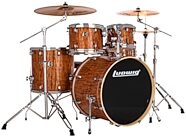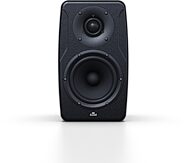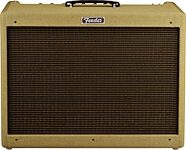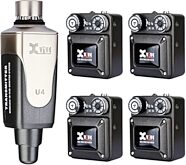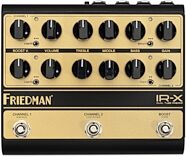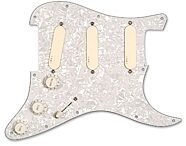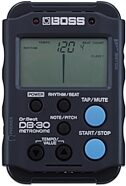
Boss DB-30 Dr. Beat Metronome
With 24 beat variations and 9 rhythm patterns, the Boss DB-30 is a great solution to all your time-keeping needs.
Boss DB-90 Dr. Beat Metronome
No longer available at zZounds
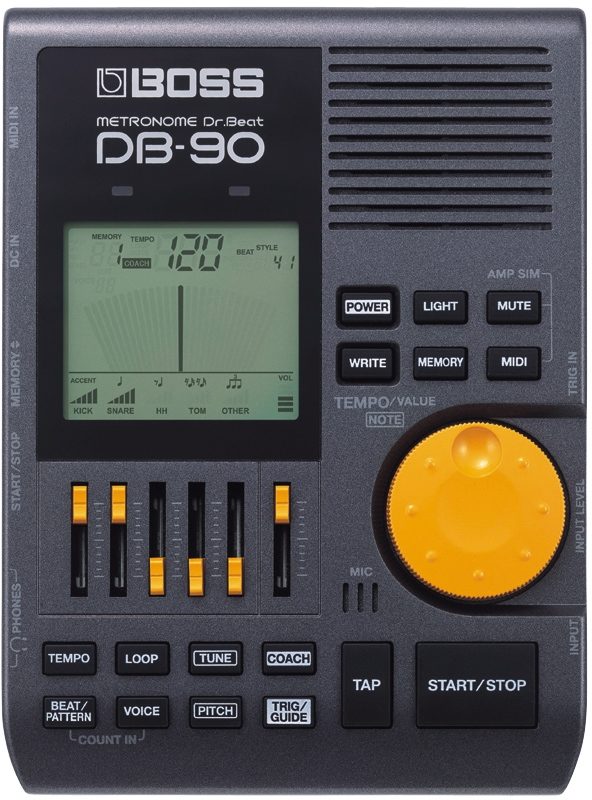
The Boss DB-90 is the flagship metronome of the Boss Dr. Beat series of metronomes.
Overview
Practice in style with the flagship of the Dr. Beat Metronome line. The Boss DB-90 is loaded with quality sounds and drum patterns to make your practice sessions less mundane and more musical. There's a Rhythm Coach function with an onboard mic, a reference-tone function for tuning, an Instrument input, MIDI input, and other handy tools to make learning fun and effective.
- Dedicated sliders, buttons, rotary dial, and large backlit LCD for user-friendly operation
- 4 metronome (including human voice) sounds
- Reference Tone function makes it easy to verify tuning by ear
- Practice with the Rhythm Coach by connecting a V-Pad (optional) -- rubber pads and acoustic drums can also be detected via built-in mic
- Direct connection with guitar and bass, plus headphone monitoring
- Footswitch control for hands-free play/stop, and MIDI input for sync to external sequencers
Features
- Quick rhythm customizing with note mixing function, dozens of play-along drum patterns also built in- Dedicated sliders, buttons, rotary dial, and large backlit LCD for user-friendly operation
- 4 metronome (including human voice) sounds
- Reference Tone function makes it easy to verify tuning by ear
- Practice with the Rhythm Coach by connecting a V-Pad (optional) -- rubber pads and acoustic drums can also be detected via built-in mic
- Direct connection with guitar and bass, plus headphone monitoring
- Footswitch control for hands-free play/stop, and MIDI input for sync to external sequencers
Better Beats, Better Practice
The Note Mixing function allows you to instantly create a variety of beats by adjusting the levels of five different note values. Front-panel sliders, buttons, and a large rotary dial provide instant, hands-on access to edit parameters. Select four different click sounds, including a human voice-counting sound that will help you know your place in the bar. The Boss DB-90 is also equipped with realistic PCM drum patterns, for developing your accuracy and rhythmic… read more feel effectively.Plug In with Rhythm Coach
Expand your rhythmic horizons with Rhythm Coach. This innovative follow-along feature has four training modes to help build your accuracy, speed, and endurance. With the Boss DB-90's onboard microphone, you can use the Rhythm Coach functions with acoustic drums, or plug a Roland V-Pad into the trigger input. Play along, and chart your progress.Many Uses
Drummers can connect to the Boss DB-90 via Roland V-Pads or the internal microphone. Guitarist and bassist can directly plug into the Boss DB-90 without any other gear required, and monitor via connected headphones -- practically any type of instrumentalist can benefit from the Boss DB-90's features. And for those who wish to sync to an external sequencer for more elaborate accompaniment, they can do so with the Boss DB-90's MIDI input. This stage-oriented feature is especially useful for drummers. read lessSpecs
Metronome:
-- Tempo: 30-250 (Accuracy: +/- 0.1%)
-- Beat: (beat1) 1-9, (beat2) off/1-9
-- Pattern: 8-beat x 4, 16-beat x 3, shuffle x 3, funk x 2, jazz x 2, blues, techno, house, country, reggae, clave 3-2, clave 2-3, salsa, rumba, bossa nova, samba, waltz, tango, mambo, chachacha, march (30 kinds)
Rhythm coach: time check, quiet count, gradual up/down, step up/down
Reference Tone:
-- Reference pitch: A4=438 Hz-445 Hz (1 Hz steps)
-- Reference tone range: C2-B6 (5 octave, 12 semitone)
Memory:
-- Metronome: 50
-- Reference tone: 10
Auto Power Off function: turns unit off after 60 min
Indicators: LCD display, tempo indicator LED x 2
Connectors:
-- Trig in jack
-- Start/stop jack
-- Memory up/down jack
-- MIDI IN connector
-- Phones jack x 2 (stereo 1/4 in. phone type, stereo miniature phone type)
-- Input jack
-- AC adapter jack
Power Supply: Dry Battery (6LR61/9V, 6AM6/9V) or AC adapter (PSA series)
Accessories: Dry Battery (9V), soft case, owner's manual
Dimensions (W x D x H): 4 13/16 x 6 1/2 x 1 1/2 in.
Weight: 1 lbs.
-- Tempo: 30-250 (Accuracy: +/- 0.1%)
-- Beat: (beat1) 1-9, (beat2) off/1-9
-- Pattern: 8-beat x 4, 16-beat x 3, shuffle x 3, funk x 2, jazz x 2, blues, techno, house, country, reggae, clave 3-2, clave 2-3, salsa, rumba, bossa nova, samba, waltz, tango, mambo, chachacha, march (30 kinds)
Rhythm coach: time check, quiet count, gradual up/down, step up/down
Reference Tone:
-- Reference pitch: A4=438 Hz-445 Hz (1 Hz steps)
-- Reference tone range: C2-B6 (5 octave, 12 semitone)
Memory:
-- Metronome: 50
-- Reference tone: 10
Auto Power Off function: turns unit off after 60 min
Indicators: LCD display, tempo indicator LED x 2
Connectors:
-- Trig in jack
-- Start/stop jack
-- Memory up/down jack
-- MIDI IN connector
-- Phones jack x 2 (stereo 1/4 in. phone type, stereo miniature phone type)
-- Input jack
-- AC adapter jack
Power Supply: Dry Battery (6LR61/9V, 6AM6/9V) or AC adapter (PSA series)
Accessories: Dry Battery (9V), soft case, owner's manual
Dimensions (W x D x H): 4 13/16 x 6 1/2 x 1 1/2 in.
Weight: 1 lbs.
Reviews
Reviewers gave this product an overall rating of 5 out of 5 stars.
(35 ratings)
Submitted January 1, 2013 by Paul F in Monticello, IA
"Phenomenal metronome"
Verified Customer
zZounds has verified that this reviewer made a purchase from us.
I have been using this metronome for almost two years and have never used another metronome as impressive as this one. Some of this review gets a little technical as I attempt to address some other reviewers’ concerns. Don’t be discouraged by my language. This metronome is easy and intuitive to work with.
There are many metronomes with extra features, mostly options of different time signatures and different divisions of the beat. I have tried several of these metronomes and have been mostly disappointed. They make an unmusical sound, or they are not loud enough, or what is most annoying, the accented divisions of the beat sound unaccented while the unaccented divisions of the beat sound accented. This shortcoming creates confusion that negates the advantages of these features. I could just as well use a basic metronome that lacks these features. There are many good basic metronomes. Simply setting a basic metronome to the eighth note and setting the metronome to double the tempo of the quarter note accomplishes much of what a more elaborate metronome attempts. But with this procedure, it is easy to get a half beat off without realizing it. A metronome that sounds different rhythms should solve this problem. But if the sound of the accented and unaccented divisions of the beat is not intuitive, the purpose of this feature is defeated.
The DB 90 has none of the above-mentioned problems. The matter of the accented and unaccented divisions of the beat is handled…
read more
superbly through volume controls for each division of the beat.
The DB 90 has four sounds, three of which I consider excellent. I use exclusively the first sound which is a simple traditional metronome sound. The second and third sounds I don't like as much, so I don't use them, but if they were the only sounds, I would still like this metronome. I strongly dislike the fourth sound, which imitates the human voice. Some people like it. The metronome also offers the possibility of accenting the first beat of a measure with a bell-like sound. This feature works well. (OK, with the bell I use two sounds.)
The selecting of different rhythms through volume controls is an extremely easy approach, far easier than what I have found on other metronomes. It can also be done very quickly, unlike other metronomes.
In response to one reviewer, it is possible to make the metronome produce three against four. Simply set the controls to produce the main beat (quarter note), the half beat (eighth note), and the second and fourth quarter beats (sixteenth notes). This will produce four divisions of the beat. Then add the triplets, and you will have three against four. More simply set all the volume controls to make audible sound. Eliminating the second and fourth sixteenths will produce two against three.
This metronome can be controlled with pedals. I find this handy when practicing music in sections, each of which is in a different tempo. By using the memory feature, merely stepping on the pedal switches the metronome to the next tempo. If I want to ritard at the end of a section, I simply ignore the metronome at that point. The metronome can also be started and stopped with a pedal. So, I conceivably could achieve more control by using two pedals!
This metronome is expensive, and when you purchase add-ons such as a pedal and a power adapter, which you will need, it is quite an outlay of money. But it is the only elaborate metronome other than the Korg KDM-2, that I would recommend. The other elaborate metronomes are too frustrating to use. A basic no-frills metronome is just as good as most metronomes with frills, often better when you consider the insufficient volume of many frilly metronomes.
Don’t be discouraged by the hassle and expense of add-ons. The metronome is very versatile without any of the add-ons, except you will need a power adapter.
This metronome is a little bulky for moving around. I use the cymbal stand screw to attach it to an eyehook screwed into the wall and mostly leave it there. It is easy to remove it from the wall. But when I want a portable metronome, I usually use the Korg KDM-2. See my review of this metronome.
This metronome, even though it has many features, is very easy to use. I have only described the main features. If you purchase one, I recommend downloading a set of instructions from the Boss DB-90 web page. These instructions will give some information not found in the instructions that come in the box.
Musical Background:
I have played keyboards for 50 years and have a master degree in organ performance.
Musical Style:
mostly classical, otherwise fairly broad read less
Musical Background:
I have played keyboards for 50 years and have a master degree in organ performance.
Musical Style:
mostly classical, otherwise fairly broad read less
8 of 8 people (100%) people found this review helpful. Did you?
Thanks for your opinion!
No longer available at zZounds
This is a carousel with product cards. Use the previous and next buttons to navigate.



